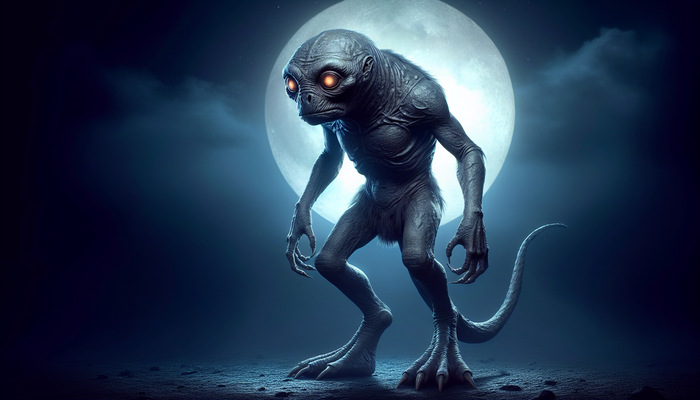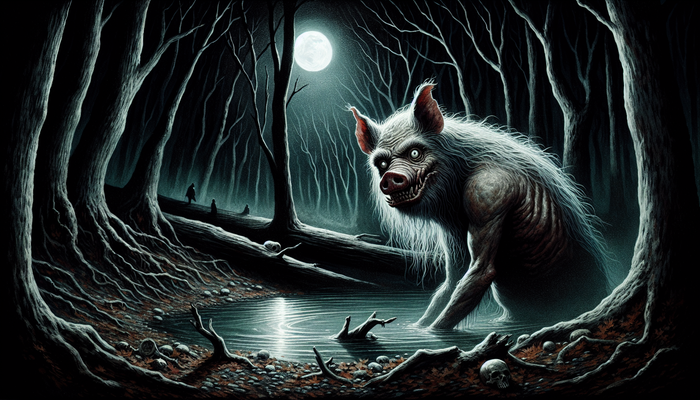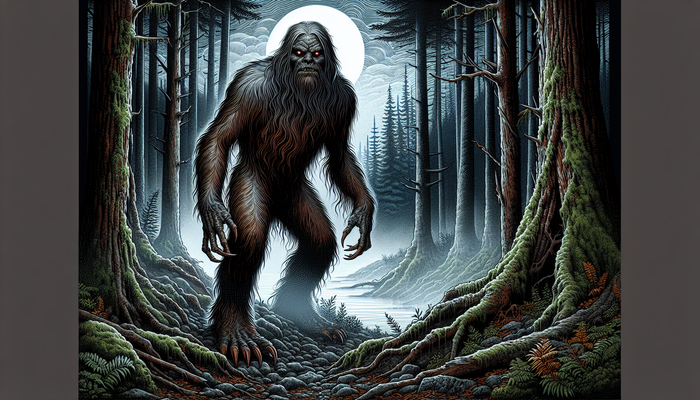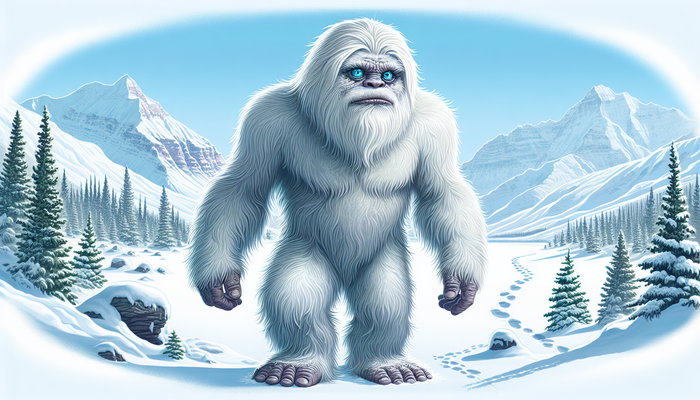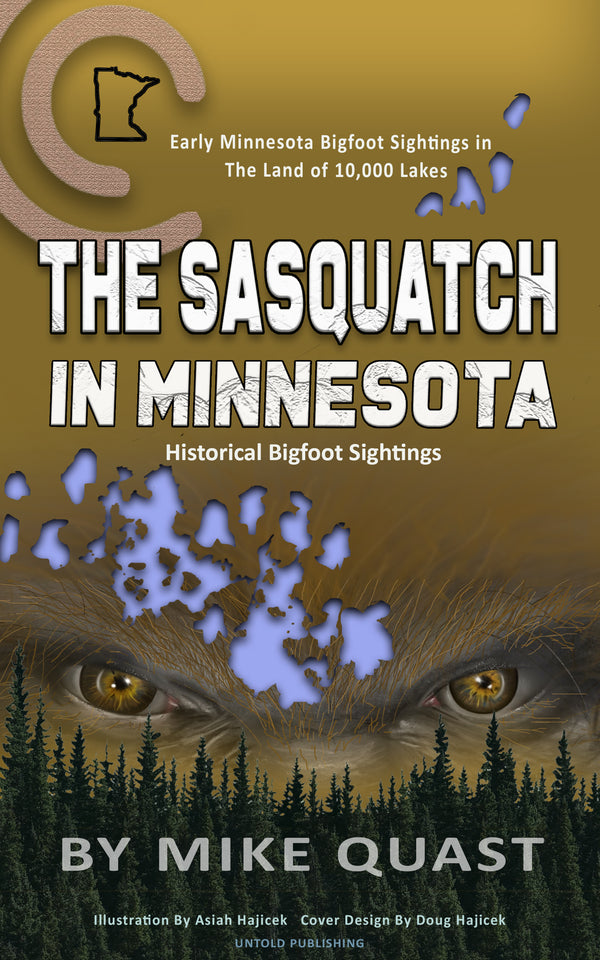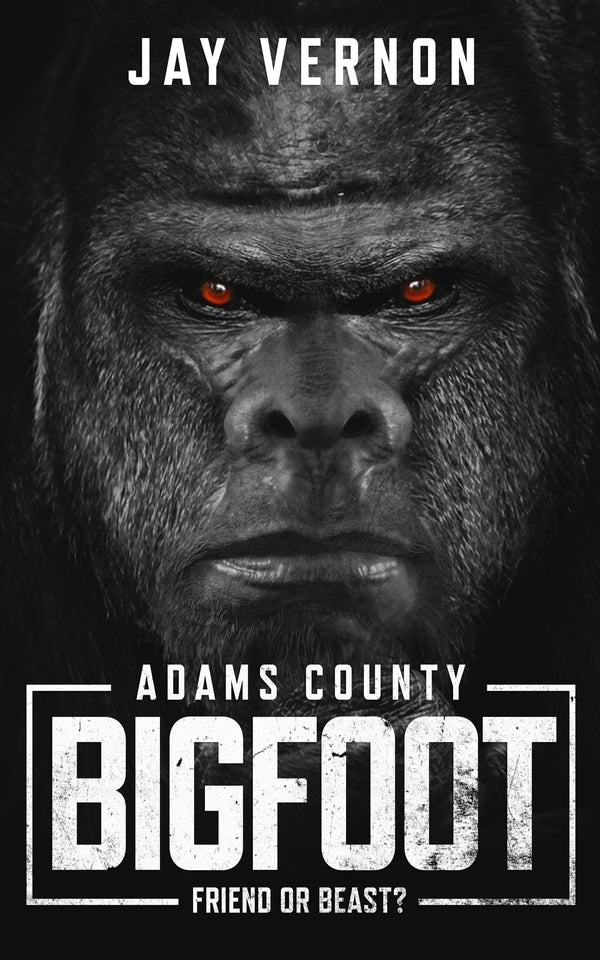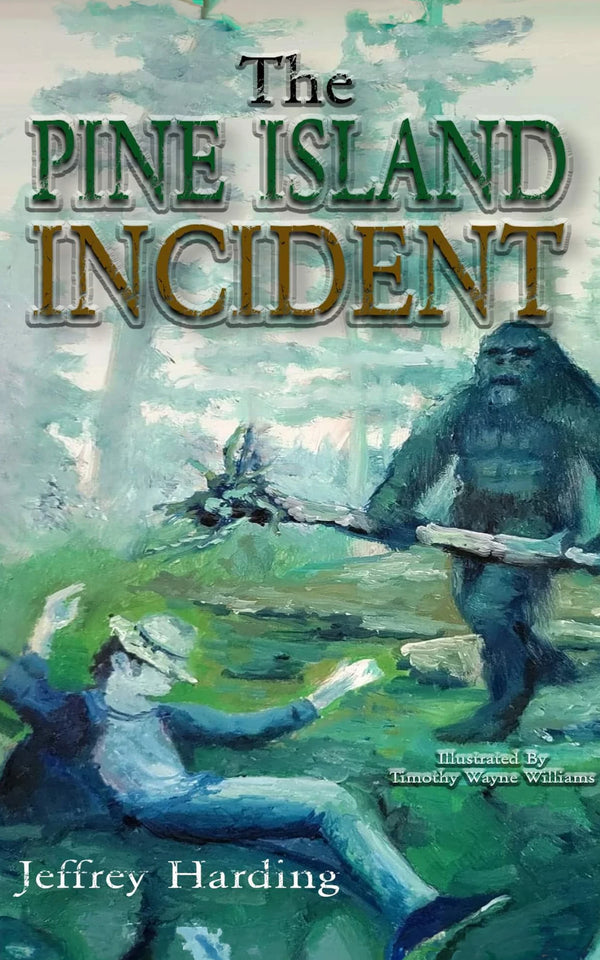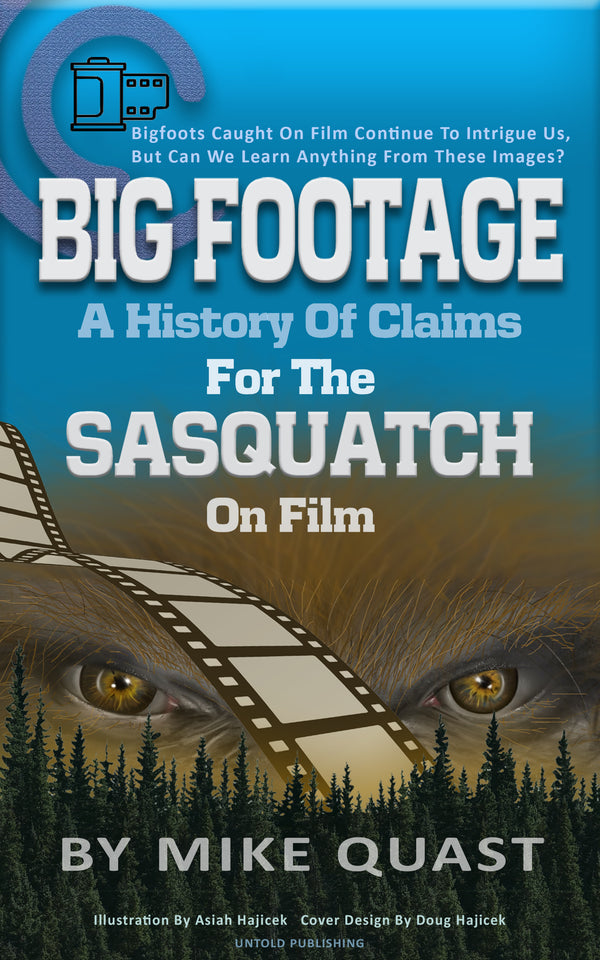The Yowie: Australia's Bigfoot
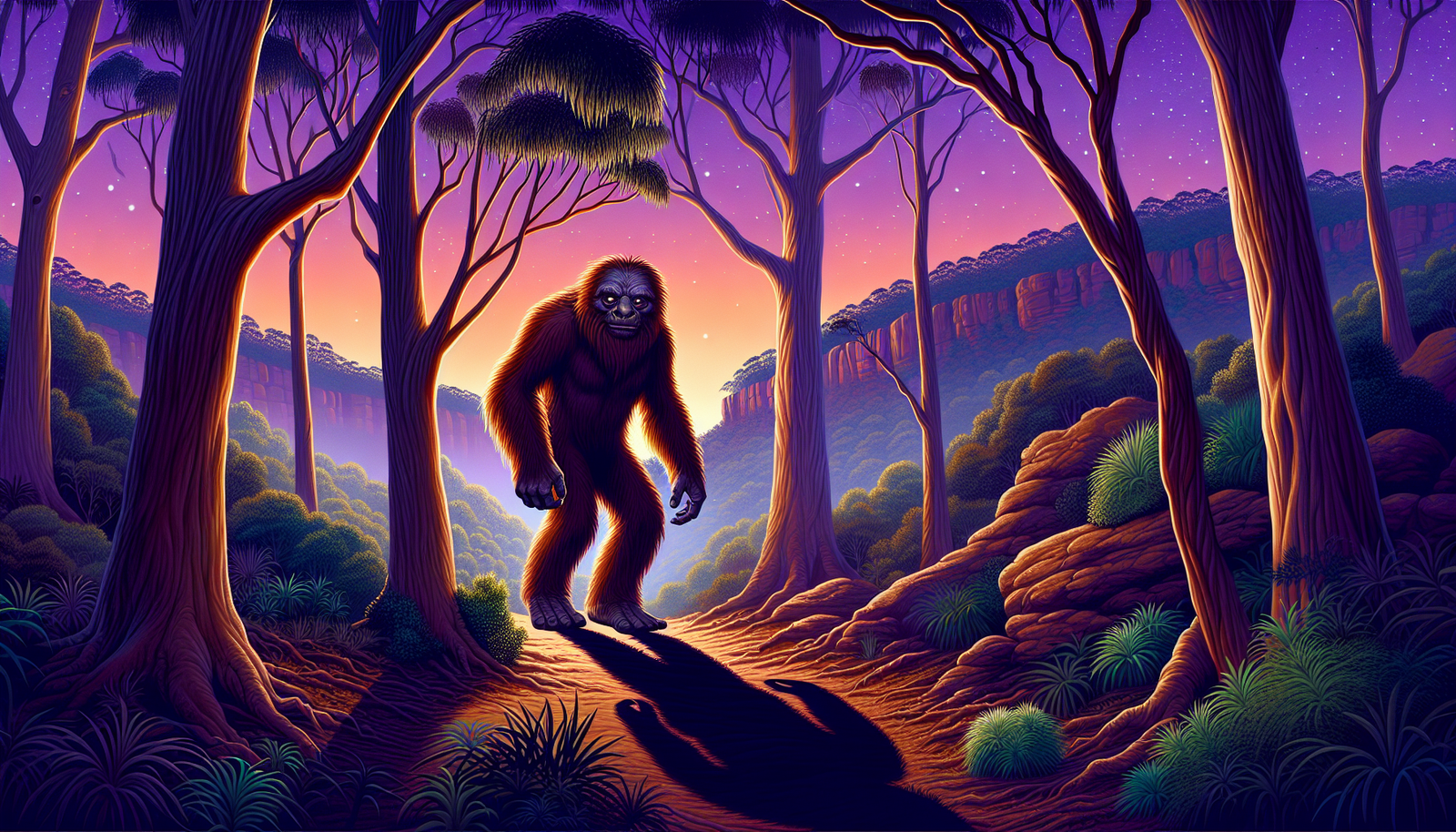
By Lucas Jennings, Cryptozoologist
As I stand at the edge of the dense Australian bush, the air thick with the scent of eucalyptus and the distant call of kookaburras, I can't help but feel a sense of anticipation. For centuries, these ancient forests have harbored a secret - a creature that has captivated the imaginations of both Indigenous Australians and European settlers alike. This enigmatic being, known as the Yowie, is Australia's answer to the legendary Bigfoot, a creature that has sparked debates, inspired countless expeditions, and left an indelible mark on the country's folklore.
The Yowie, with its towering stature and elusive nature, represents more than just a cryptozoological curiosity. It embodies the enduring mystery of the Australian wilderness, a vast and often unforgiving landscape that still holds secrets waiting to be uncovered. As a researcher and writer who has dedicated years to studying cryptids and unexplained phenomena, I've found myself irresistibly drawn to the legend of the Yowie. It's a tale that intertwines Indigenous wisdom, colonial encounters, and modern scientific inquiry in a fascinating tapestry of belief and skepticism.
In this comprehensive exploration, we'll delve deep into the world of the Yowie, tracing its origins in Aboriginal folklore, examining the myriad of eyewitness accounts that span over two centuries, and scrutinizing the ongoing research efforts to prove its existence. We'll also confront the skepticism that surrounds the Yowie, analyzing the arguments of those who dismiss it as mere myth or misidentification.
But this journey is about more than just determining whether the Yowie exists. It's an opportunity to explore the human fascination with the unknown, to understand how legends shape our perception of the natural world, and to appreciate the rich cultural heritage that gives rise to such enduring mysteries.
As we embark on this adventure, I invite you to open your mind to the possibilities. Whether you're a staunch believer, a curious skeptic, or somewhere in between, the story of the Yowie offers something for everyone. It challenges us to question what we think we know about the natural world and reminds us that there may still be wonders waiting to be discovered in the shadows of our modern world.
So, let's step into the world of the Yowie together. Let's explore the dense forests and rugged mountains where this creature is said to roam. Let's listen to the stories of those who claim to have encountered it, examine the evidence put forth by researchers, and consider the cultural significance of this enduring legend.
Are you ready to unravel the mystery of Australia's most elusive cryptid? Then join me as we venture into the heart of Yowie country, where the line between myth and reality blurs, and the echoes of ancient stories still resonate through the land.
Origins of the Yowie
Aboriginal Folklore
To truly understand the Yowie, we must first journey back in time, delving into the rich tapestry of Aboriginal folklore that has woven this creature into the very fabric of Australia's cultural landscape. The Indigenous peoples of Australia, with their deep connection to the land and its spirits, have long spoken of beings that defy easy categorization - creatures that bridge the gap between the physical and spiritual realms.
As I've traveled across Australia, speaking with Aboriginal elders and studying ancient rock art, I've come to appreciate the complexity and diversity of Indigenous beliefs surrounding the Yowie. It's crucial to note that Aboriginal Australia is not a monolith; it's a mosaic of hundreds of distinct language groups and cultures, each with its own unique stories and traditions.
In the languages of various Aboriginal groups, the Yowie goes by many names. The Kamilaroi people of New South Wales know it as "doolagarl," while in other regions it's called "jurrawarra," "thoolagarl," or "tjangara." Each name carries its own nuances and associations, reflecting the specific beliefs and experiences of the people who use it.
One particularly evocative description comes from the Bundjalung people of coastal New South Wales, who speak of the "Joongarra" or "Yoocum." According to their oral traditions, these beings are immensely strong and covered in long hair. They're said to inhabit the deepest parts of the forest, emerging at night to hunt and forage.
The significance of the Yowie in Aboriginal mythology is multifaceted and often paradoxical. In some stories, it's portrayed as a guardian spirit, a protector of the land and its creatures. I recall an elder from the Yuin people telling me how the Yowie would appear to warn of impending danger or to guide lost children back to their families.
In other traditions, however, the Yowie takes on a more sinister aspect. It's described as a fearsome predator, capable of carrying off unwary travelers or those who disrespect the land. These contrasting portrayals reflect the complex relationship between Indigenous Australians and their environment - a relationship characterized by both reverence and caution.
One of the most intriguing aspects of Aboriginal Yowie lore is how it intertwines with the concept of the Dreamtime - the Aboriginal understanding of the world's creation and the ongoing spiritual reality that underpins all existence. In many stories, the Yowie is not just a physical creature but a being that exists in both the tangible world and the realm of spirits.
For example, the Githabul people of the Queensland-New South Wales border region speak of the "Joogabinna," a Yowie-like creature that they believe has inhabited the area since the Dreamtime. According to their traditions, the Joogabinna were once much more numerous and would interact with humans, sometimes even intermarrying with them. These stories suggest a deep ancestral connection between humans and Yowie-like beings, blurring the lines between myth, history, and spiritual belief.
It's also worth noting that in many Aboriginal cultures, the Yowie is not seen as a single type of creature but as a diverse group of beings. The Kuku Yalanji people of Far North Queensland, for instance, distinguish between several types of hairy hominids. There's the large, aggressive "Imjim," the smaller, more docile "Njmbin," and the mischievous child-sized "Junjdy." Each of these beings has its own characteristics and plays a different role in the spiritual ecology of the land.
The diversity of Yowie-like creatures in Aboriginal lore presents an interesting parallel to the varied descriptions found in modern sightings. Could this ancient knowledge hold clues to understanding the nature of the Yowie phenomenon? It's a question that continues to intrigue researchers and enthusiasts alike.
As we delve deeper into the Aboriginal origins of the Yowie, it becomes clear that these stories are far more than simple monster tales. They are part of a complex system of knowledge that encompasses spirituality, ecology, and social norms. The Yowie, in its many forms, serves as a powerful symbol of the unknown, a reminder of the mysteries that still exist in the natural world, and a link to the ancient wisdom of Australia's first peoples.
However, it's crucial to approach these stories with respect and cultural sensitivity. As a researcher, I've learned that many Aboriginal communities are hesitant to share their knowledge of the Yowie with outsiders, viewing it as sacred information that should be protected. This reticence adds another layer of mystery to the Yowie legend and underscores the importance of preserving Indigenous cultural heritage.
As we transition from the realm of Aboriginal folklore to the first European encounters with the Yowie, we'll see how these ancient stories began to intersect with Western concepts of cryptozoology and the unknown. The collision of these two worldviews would give birth to the modern Yowie phenomenon, setting the stage for over two centuries of sightings, research, and speculation.
European Encounters
The arrival of European settlers in Australia marked a new chapter in the Yowie story, one that would see ancient Aboriginal legends collide with Western scientific thought and the colonial imagination. As these newcomers ventured into the vast, unfamiliar Australian wilderness, they brought with them their own preconceptions about nature and the unknown, setting the stage for a fascinating cultural exchange that would shape the modern understanding of the Yowie.
The first recorded European sightings of Yowie-like creatures date back to the late 18th century, coinciding with the earliest days of British colonization. One of the earliest and most intriguing accounts comes from 1795, just seven years after the establishment of the penal colony at Sydney Cove. A group of convicts and marines, venturing into the Blue Mountains west of Sydney, reported encountering a creature they described as "a huge animal of the baboon species."
This sighting is particularly significant not just for its early date, but for the way it exemplifies the European tendency to interpret the unknown through familiar lenses. The comparison to a baboon - an animal not native to Australia - reveals how these early settlers struggled to categorize the strange beings they encountered in this new land.
As more Europeans pushed into the interior of the continent, reports of mysterious, ape-like creatures began to accumulate. These beings were often referred to as "yahoos" or "youries," terms that would eventually evolve into the modern name "Yowie." The use of the term "yahoo" is particularly interesting, as it draws a direct line to Jonathan Swift's satirical novel "Gulliver's Travels," published in 1726.
In Swift's book, the yahoos are brutish, humanoid creatures encountered by the protagonist during his travels. The adoption of this term by Australian settlers suggests that they were drawing on literary and cultural references to make sense of their experiences in this strange new land. It's a fascinating example of how folklore and literature can shape our perception of the unknown.
One of the most detailed early accounts of a Yowie encounter comes from 1842, published in the "Australian and New Zealand Monthly Magazine." The article describes the beliefs of Aboriginal people regarding a creature they called the "Yahoo-Devil Devil":
"The natives of Australia ... believe in ... [the] YAHOO ... This being they describe as resembling a man ... of nearly the same height, ... with long white hair hanging down from the head over the features ... the arms as extraordinarily long, furnished at the extremities with great talons, and the feet turned backwards, so that, on flying from man, the imprint of the foot appears as if the being had travelled in the opposite direction. Altogether, they describe it as a hideous monster of an unearthly character and ape-like appearance."
This description is notable for several reasons. First, it demonstrates how European settlers were beginning to take an interest in Aboriginal beliefs about these creatures. Second, it shows how these beliefs were being filtered through a European perspective, with the creature being described in terms that would be familiar to a Western audience.
As the 19th century progressed, Yowie sightings became more frequent and more widely reported. Newspapers of the era often carried accounts of encounters with "Australian apes" or "wild men of the woods." These stories captured the public imagination, blending elements of adventure, mystery, and the exotic allure of the Australian wilderness.
One particularly notable case occurred in 1876, when the "Australian Town and Country Journal" published a series of letters from readers claiming to have seen or heard of Yowie-like creatures. One correspondent wrote:
"Who has not heard, from the earliest settlement of the colony, the blacks speaking of some unearthly animal or inhuman creature ... namely the Yahoo-Devil Devil, or hairy man of the woods ..."
This flurry of reports in the late 19th century marks a turning point in the Yowie phenomenon. No longer confined to isolated encounters or Aboriginal legends, the Yowie was becoming a part of mainstream Australian culture. It was during this period that the modern concept of the Yowie as a cryptozoological entity - a hidden animal awaiting scientific discovery - began to take shape.
However, it's important to note that these early European encounters with the Yowie were not simply a matter of discovering a new species. They were part of a complex process of cultural interpretation and reinterpretation. European settlers were not just seeing strange creatures in the bush; they were engaging with a landscape steeped in tens of thousands of years of Aboriginal history and spirituality.
The evolution of the Yowie from an Aboriginal spiritual entity to a cryptozoological mystery reflects the broader changes taking place in Australian society during this period. As European scientific rationalism began to dominate, the Yowie was increasingly viewed through the lens of zoology rather than spirituality. This shift would set the stage for the modern era of Yowie research, with its focus on gathering physical evidence and applying scientific methodologies to the study of these elusive creatures.
Yet even as the Yowie was being reimagined in Western terms, echoes of its Aboriginal origins persisted. Many European accounts of Yowie encounters included references to the creatures' supernatural abilities or their connection to spiritual realms. This blending of Aboriginal and European perspectives would continue to characterize the Yowie phenomenon, creating a uniquely Australian cryptid that defies easy categorization.
As we move forward in our exploration of the Yowie, we'll see how these early European encounters laid the groundwork for over two centuries of sightings, research, and speculation. The collision of Aboriginal wisdom and European scientific inquiry that began in the late 18th century continues to shape our understanding of the Yowie to this day, making it one of the most enduring and intriguing mysteries of the Australian wilderness.
Descriptions and Characteristics
Physical Attributes
As we delve deeper into the world of the Yowie, one of the most fascinating aspects to explore is the creature's physical appearance. Over the years, I've collected and analyzed hundreds of eyewitness accounts, and while there's certainly variation in the details, a consistent picture of the Yowie's physical attributes has emerged. Let's examine these characteristics in detail, drawing on both historical accounts and modern sightings to paint a comprehensive portrait of Australia's most enigmatic cryptid.
Size and Stature
One of the most striking features of the Yowie is its impressive size. Eyewitness reports consistently describe a creature that towers over human beings, with height estimates ranging from 2.1 meters (about 6 feet 11 inches) to a truly gigantic 3.6 meters (12 feet). This extreme variation in reported heights has led some researchers to speculate that there might be multiple species or subspecies of Yowie, each with its own size range.
The majority of sightings, however, cluster around the 2.1 to 2.7 meter (7 to 9 foot) range. To put this into perspective, imagine a being that could easily peer into a second-story window or reach the top branches of a small tree without stretching. This imposing stature is often one of the first things that witnesses mention, and it contributes significantly to the awe and fear that Yowie encounters typically inspire.
Body Structure
The Yowie is invariably described as having a robust, muscular build. Witnesses often compare its physique to that of a bodybuilder or a gorilla, emphasizing powerful shoulders, a broad chest, and strong limbs. This muscular structure is frequently cited as evidence of the creature's incredible strength, with accounts of Yowies effortlessly breaking thick branches or moving heavy objects.
One particularly interesting aspect of the Yowie's body structure is the reported absence of a visible neck. Many witnesses describe the head as sitting directly on the shoulders, giving the creature a hunched appearance. This feature is reminiscent of descriptions of other cryptids like the North American Bigfoot or the Himalayan Yeti, suggesting a possible common ancestry or convergent evolution.
Facial Features
The face of the Yowie is one of its most distinctive and unsettling features. Eyewitness accounts consistently describe a flat, wide nose that dominates the facial structure. This nose is often compared to that of a gorilla, but with human-like nostrils. The mouth is typically described as being unusually large, sometimes stretching from ear to ear, with witnesses often noting the visibility of teeth.
The eyes of the Yowie are another point of fascination. They are frequently described as being large and expressive, with colors ranging from deep brown to a startling red or yellow. Many witnesses report feeling a sense of intelligence or awareness in these eyes, adding to the uncanny, almost human-like quality of the creature.
The Yowie's brow is often described as being heavy and protruding, similar to that of our ancient hominid ancestors. This feature, combined with the flat nose and large mouth, gives the Yowie a distinctly primitive appearance that aligns with theories suggesting it could be a relict population of an extinct human species.
Hair and Skin
Perhaps the most defining characteristic of the Yowie is its coat of hair. Virtually all accounts describe the creature as being covered in thick, shaggy fur from head to toe. The length of this hair varies in reports, with some describing it as relatively short (a few inches long) while others claim it hangs in matted clumps that reach nearly to the ground.
The color of the Yowie's hair is another point of variation in eyewitness accounts. The most commonly reported colors are various shades of brown, ranging from a light reddish-brown to a deep, almost black hue. Some witnesses have reported seeing Yowies with grayish or even white hair, leading to speculation about albinism or age-related color changes in the species.
Interestingly, a few accounts mention patches of bare skin, particularly on the face, palms, and soles of the feet. This bare skin is typically described as being dark in color, similar to that of a gorilla. The presence of bare skin, especially on the face, adds to the unsettling human-like quality that many witnesses report.
Limbs and Extremities
The limbs of the Yowie are consistently described as being proportionally longer than those of humans, particularly the arms. Many witnesses report that the Yowie's arms reach down to its knees or even lower when standing upright. This feature is often cited as evidence of the creature's arboreal abilities, with some accounts describing Yowies climbing trees with remarkable agility.
The hands and feet of the Yowie are subjects of particular interest in cryptozoological circles. The hands are typically described as being large and powerful, with long fingers capable of grasping and manipulating objects. Some reports mention sharp claws, while others describe more human-like nails.
The feet of the Yowie have been the subject of much scrutiny, particularly in cases where alleged footprints have been found. These prints are often described as being much larger than human feet, sometimes measuring up to 45 centimeters (18 inches) in length. The shape of the foot varies in reports, with some describing a more human-like foot structure while others report a more ape-like foot with an opposable big toe.
One of the most intriguing aspects of Yowie foot descriptions is the reported variation in toe number. While most accounts describe five toes, similar to humans and great apes, there are a significant number of reports that mention three-toed or even four-toed footprints. This variation has led to much speculation and debate among researchers, with some suggesting that it could indicate multiple species of Yowie, while others argue that it's evidence of misidentification or hoaxing.
Sexual Dimorphism
While many eyewitness accounts don't specify the sex of the Yowie observed, there are enough reports of apparent male and female individuals to suggest some degree of sexual dimorphism in the species. Female Yowies are often described as being slightly smaller than males, with some reports mentioning the presence of breasts. Male Yowies, on the other hand, are typically described as being larger and more muscular, with some accounts mentioning the presence of sagittal crests (a ridge of bone running along the top of the skull, often seen in male gorillas).
It's worth noting that the presence of sexual dimorphism, if confirmed, would be a strong indicator that the Yowie represents a breeding population rather than isolated individuals or misidentified known animals. This aspect of Yowie physiology remains an area of active research and debate among cryptozoologists.
Adaptations to Environment
Many of the physical attributes reported in Yowie sightings suggest adaptations to the Australian environment. The creature's large size and muscular build would be advantageous for navigating the rugged terrain of the Australian bush, while its long arms and reported climbing ability would allow it to move through trees when necessary.
The thick coat of hair described in most sightings could serve as protection against the harsh Australian sun and the scratches and cuts that would inevitably result from moving through dense undergrowth. Some researchers have speculated that the Yowie's reported ability to remain motionless for long periods, blending in with its surroundings, could be an adaptation for avoiding detection by both prey and potential threats.
Comparisons to Other Cryptids
When examining the physical attributes of the Yowie, it's impossible not to draw comparisons to other reported cryptids around the world, particularly the North American Bigfoot and the Himalayan Yeti. The similarities in size, body structure, and hair coverage are striking and have led some researchers to speculate about a common origin for these creatures.
However, there are also notable differences. The Yowie's reported facial features, particularly its wide, flat nose and large mouth, seem to be more pronounced than those described in Bigfoot sightings. Additionally, the variation in foot structure and toe number reported in Yowie sightings is not typically seen in accounts of other cryptids.
These similarities and differences raise intriguing questions about the potential relationships between these creatures and their evolutionary history. Could the Yowie represent a unique adaptation of a common ancestral species to the Australian environment? Or is it a completely distinct creature that has evolved in isolation on the Australian continent? These are questions that continue to drive research and speculation in the field of cryptozoology.
As we conclude our examination of the Yowie's physical attributes, it's important to remember that these descriptions are based on eyewitness accounts and alleged physical evidence. While the consistency across many reports is compelling, the lack of definitive physical proof means that all of these characteristics must be considered speculative to some degree.
Nevertheless, the detailed and often strikingly similar descriptions provided by witnesses from diverse backgrounds and across different time periods suggest that there is something out there in the Australian wilderness - something large, powerful, and decidedly unlike any known animal. Whether this something is the Yowie as described, or whether these sightings represent misidentifications, hoaxes, or some as-yet-undiscovered phenomenon, remains one of the great mysteries of cryptozoology.
Behavioral Traits
Having explored the physical attributes commonly associated with the Yowie, we now turn our attention to perhaps an even more fascinating aspect of this cryptid: its reported behaviors. Understanding how the Yowie is said to act, move, and interact with its environment and with humans provides crucial insights into its nature and potential place in the ecosystem. As with physical descriptions, behavioral accounts vary, but certain patterns emerge that paint a picture of a complex, intelligent creature that defies easy categorization.
Locomotion and Movement
One of the most frequently reported behaviors of the Yowie is its distinctive way of moving. Witnesses consistently describe the creature as bipedal, walking upright on two legs in a manner similar to, yet distinct from, human gait. The Yowie's walk is often characterized as having a fluid, powerful quality, with long strides that cover ground quickly and efficiently.
Many accounts mention a slight swaying or rocking motion as the Yowie walks, which some researchers attribute to its reported large size and muscular build. This distinctive gait is often one of the first things that catches a witness's attention, even before they fully realize what they're seeing.
Interestingly, while bipedal locomotion is the norm in Yowie reports, there are also accounts of the creature moving on all fours, particularly when navigating steep or difficult terrain. This quadrupedal movement is typically described as being smooth and natural, suggesting that the Yowie is equally comfortable on two legs or four - a trait that would be highly advantageous in the varied Australian landscape.
The Yowie's reported climbing ability is another notable aspect of its locomotion. Numerous accounts describe the creatures scaling trees with remarkable speed and agility, using their long arms to swing from branch to branch in a manner reminiscent of great apes. This arboreal skill set would provide the Yowie with an excellent means of escape and concealment, as well as access to potential food sources like fruit and bird eggs.
Speed and Agility
Despite its large size, the Yowie is consistently described as being surprisingly fast and agile. Witnesses often report being astonished at how quickly the creature can move through dense bush or over rough terrain. There are accounts of Yowies outpacing vehicles on forest roads and effortlessly clearing obstacles that would stymie a human pursuer.
This combination of speed and agility is particularly evident in accounts of Yowies evading detection. Many witnesses describe the creature's ability to seemingly vanish into the bush in the blink of an eye, moving with a silence that belies its size. This skill at rapid, stealthy movement has led some researchers to speculate that the Yowie may possess sensory capabilities beyond those of known primates, possibly including enhanced night vision or acute hearing.
Strength and Power
Tales of the Yowie's incredible strength are common in eyewitness accounts. There are numerous reports of Yowies effortlessly breaking thick branches, uprooting small trees, or moving heavy objects like logs or rocks. Some of the more dramatic accounts describe Yowies flipping over vehicles or tearing apart sturdy structures.
While such feats of strength might seem exaggerated, they align with what we might expect from a creature of the Yowie's reported size and build. If the Yowie does indeed exist and is related to known primates, it's not unreasonable to assume it would possess strength far beyond that of a human, similar to the way gorillas can exhibit feats of strength that far outstrip human capabilities.
Vocalizations
One of the most intriguing aspects of Yowie behavior is the wide range of vocalizations attributed to the creature. Witnesses report hearing everything from low, guttural growls to high-pitched screams and howls. Some of the most commonly described Yowie vocalizations include:
- Wood knocks: Many accounts mention hearing loud, deliberate knocking sounds, as if a heavy stick were being struck against a tree. This behavior is interestingly similar to that reported in Bigfoot encounters in North America.
- Whoops and howls: Witnesses often describe hearing long, drawn-out howls or whooping sounds, sometimes in a series or as if in response to another distant call.
- Screams: Perhaps the most unsettling of Yowie vocalizations are the screams. These are frequently described as sounding unnervingly human-like, yet with a power and resonance beyond normal human capability.
- Growls and grunts: Lower-pitched vocalizations are also commonly reported, ranging from deep, rumbling growls to short, sharp grunts.
- Language-like sounds: In a few rare cases, witnesses have reported hearing sounds that seemed to have a language-like quality, as if the Yowies were communicating with each other using a form of speech.
These varied vocalizations suggest a complex system of communication, which would align with the level of intelligence often attributed to the Yowie. Some researchers have attempted to record these sounds, leading to ongoing debates about their origin and meaning.
Intelligence and Tool Use
Many Yowie encounters leave witnesses with the impression that they've interacted with a highly intelligent being. This perceived intelligence manifests in various ways, from the creature's apparent ability to evade detection and traps, to more direct observations of problem-solving behavior.
There are several accounts of Yowies manipulating objects in their environment in ways that suggest tool use. These range from using sticks to probe for food to more complex behaviors like arranging branches and foliage for camouflage or shelter. While these reports are anecdotal, if confirmed, they would place the Yowie's cognitive abilities at a level comparable to or exceeding those of great apes.
Some of the more controversial accounts even suggest a level of intelligence approaching human-like cognition. There are rare reports of Yowies exhibiting curiosity about human objects, mimicking human behaviors, or even attempting rudimentary communication with humans. These accounts, while fascinating, are treated with a high degree of skepticism even within the cryptozoological community due to their extraordinary nature.
Social Behavior
While many Yowie sightings involve solitary creatures, there are enough reports of multiple individuals to suggest that they may have a social structure. Accounts of family groups, including apparent adults and juveniles, are not uncommon. These group sightings often describe behaviors that imply social bonds, such as coordinated movement, shared foraging, or even play behavior among younger individuals.
Some researchers have proposed that Yowies may live in small family units or clans, coming together occasionally in larger groups. This social structure would be similar to that observed in some great ape species and would align with the complex vocalizations and apparent intelligence attributed to the Yowie.
Interaction with Humans
The Yowie's behavior towards humans is one of the most variable and debated aspects of its reported conduct. Accounts range from complete avoidance to aggressive confrontation, with a wide spectrum of behaviors in between.
Many witnesses describe the Yowie as shy and elusive, quickly retreating when spotted. These accounts often leave the impression of a creature that is aware of humans and actively avoids contact. Some researchers interpret this behavior as evidence of intelligence and a learned wariness of human presence.
On the other hand, there are also numerous reports of more bold or aggressive behavior. These range from Yowies standing their ground and making threatening displays when encountered, to rare cases of alleged attacks on humans or human property. It's worth noting that in most of these more aggressive encounters, the Yowie's behavior could be interpreted as defensive rather than predatory.
A particularly interesting category of human-Yowie interaction involves what some researchers call "habituation" cases. These are situations where Yowies are reported to have ongoing, semi-regular interactions with humans in a specific area, often near rural properties. In these cases, the Yowies are described as becoming gradually more comfortable with human presence, sometimes even approaching homes or camps.
Foraging and Dietary Habits
Observations of Yowie foraging behavior, along with analyses of alleged Yowie scat, suggest that these creatures may be omnivorous. Witnesses have reported seeing Yowies eating a variety of foods, including:
- Vegetation: Berries, fruits, nuts, and leaves are commonly mentioned as Yowie foods.
- Insects: There are accounts of Yowies turning over logs or rocks, presumably in search of insects and grubs.
- Small animals: Some reports describe Yowies catching and eating small mammals, reptiles, or birds.
- Fish: In areas near water, there are occasional reports of Yowies fishing or foraging for aquatic life.
Interestingly, there are also accounts of Yowies scavenging from human sources, including raiding campsites or rural garbage dumps. This opportunistic feeding behavior, if accurate, would suggest a level of adaptability that could help explain the Yowie's alleged ability to survive in diverse habitats across Australia.
From Bigfoot to UFOs: Hangar 1 Publishing Has You Covered!
Explore Untold Stories: Venture into the world of UFOs, cryptids, Bigfoot, and beyond. Every story is a journey into the extraordinary.
Immersive Book Technology: Experience real videos, sights, and sounds within our books. Its not just reading; its an adventure.


